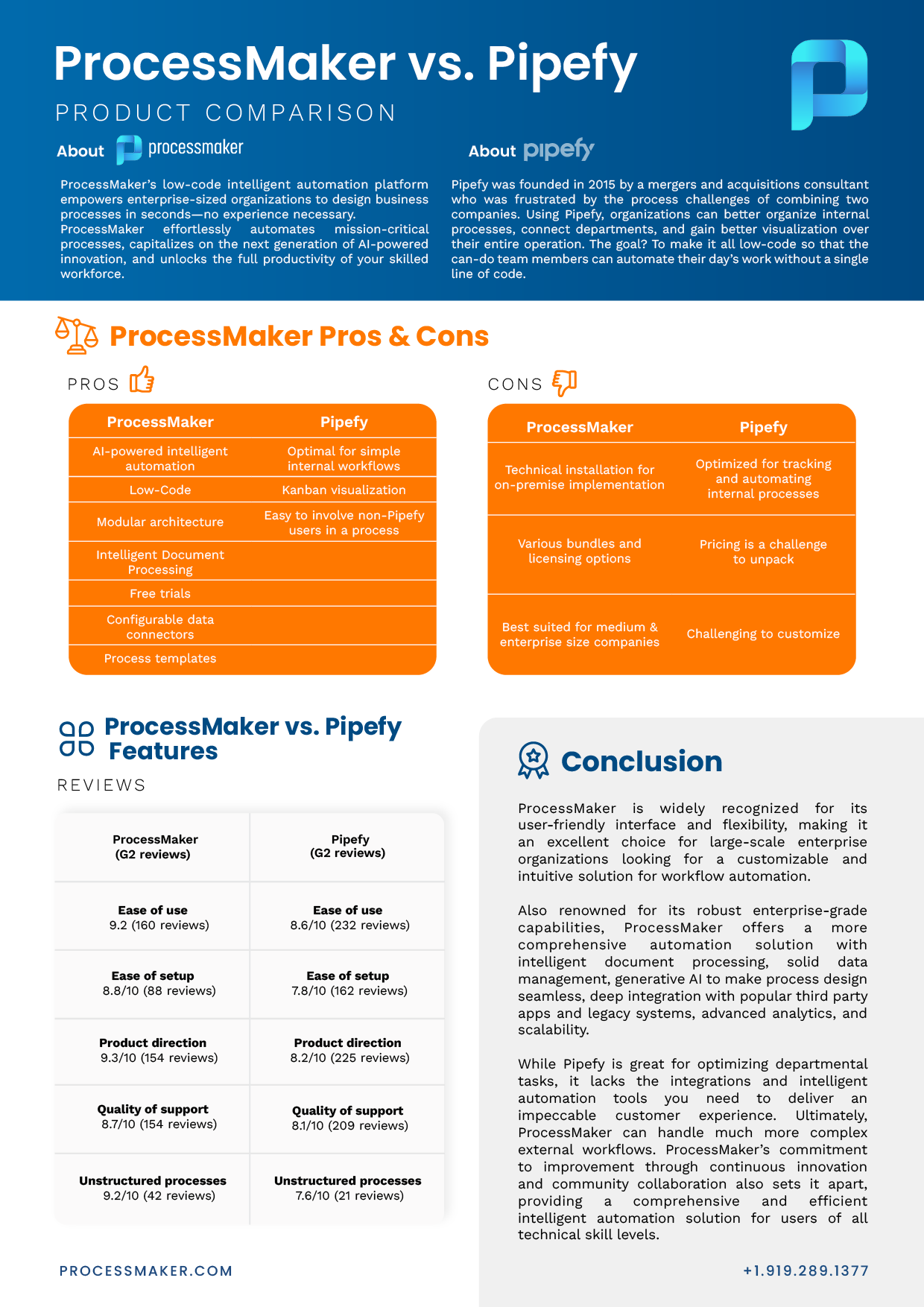Deciding between ProcessMaker and Pipefy?Download our free comprehensive BPM comparison guide
Is your enterprise still operating on a mix of disparate legacy and point solutions? Or maybe you have adopted a suite that checks many of the boxes your organization requires, but misses a few critical points that are causing your business to consider other options? Choosing between two quality platforms can be tough for any organization, but we have taken the time to create a comparison guide to help you weigh the pros and cons of your next investment in a business process management software (BPMs) platform with peace of mind.
BASED ON 400+ REVIEWS
Get the Guide

About the Guide
This document reviews Pipefy and ProcessMaker, based on their performance in various areas:
- Intuitive interface
- Low-code custom functionality
- Robust process management and optimization tools
| Reviews | |||
|---|---|---|---|

| vs | 
| |
 |
4.3/5 23 reviews | 4.6/5 177 reviews | |
 |
4.3/5 270 reviews | 4.6/5 187 reviews | |
 |
4.5/5 175 reviews | 4.6/5 278 reviews | |
Pipefy Pros & Cons
| Pros | Cons |
|---|---|
| Kanban visualization. There are two options for viewing your processes: a Kanban board or a basic list. Pipefy users give high marks to the platform’s Kanban workflow view, where they can easily see how each task moves between To Do, Doing, and Done. |
Pricing is a challenge to unpack. Pipefy offers several appealing pricing tiers. However, each has its limits. Valuable features, tagged “add-ons to power up workflows,” are only available for Enterprise and Unlimited users, creating a challenging “build your own product” model that can become increasingly pricey. |
| Simple and fast. Pipefy users laud the platform’s ease of use. The clean user interface is a plus for non-tech-savvy players. It’s manageable for teams without reliable access to IT support. |
Limited international capabilities. Currently, Pipefy is only available in three languages: English, Portuguese, and Spanish. The platform lacks robust customization features such as currency support and phone number prefix formatting, creating challenges for companies that operate on a global scale. |
| Easy to involve non-Pipefy users in a process. Public forms grant access to the form builder for non-Pipefy users. External stakeholders, job applicants, or clients can submit information that instantly slots into your workflow process. |
Optimized for tracking and automating internal processes. Pipefy is a great option for teams like HR and marketing looking to automate their departmental tasks. But for more complex external workflows, like bank account opening or loan applications, it lacks the integrations and intelligent automation tools that you need to serve an impeccable customer experience. |
ProcessMaker Pros & Cons
| Pros | Cons |
|---|---|
| True Low-Code Environment but with additional Developer tools. Design and deploy without coding knowledge needed. However, for developers that want to create custom scripts and packages to run in their environment, ProcessMaker has a full featured web IDE for designing scripts in almost any programming language. |
More Coding Knowledge Equals Better Feature Usage. An IT professional does have to write the original script tasks that serve as the building blocks for many processes, which can then be reused indefinitely by business users. |
| Pricing. Reportedly it is one of the more affordable enterprise BPM solutions. |
Single Cloud Support. ProcessMaker seems to lean toward AWS at present and its new solution is not marketed for On Premise. However, ProcessMaker is offering a unique hybrid solution with the ability to store sensitive data on premise with a connection to your cloud deployment. |
| Thorough Training and Professional Services, and Support. Numerous reviews across G2 Crowd, Capterra, and Gartner Peer Insights cite positive reception of training and support as a major factor in sticking with ProcessMaker. |
Technical Installation on Premise. ProcessMaker is built for the cloud. For users that want to run the open source on premise they will find installation difficult and all the cool enterprise features are missing in the open source. The open source core, however, is well documented and ideal for inclusion in other enterprise products. |
Discover how leading organizations utilize ProcessMaker to streamline their operations through process automation.